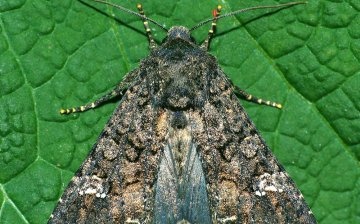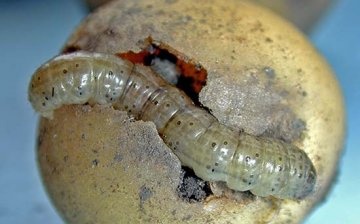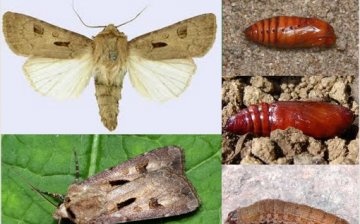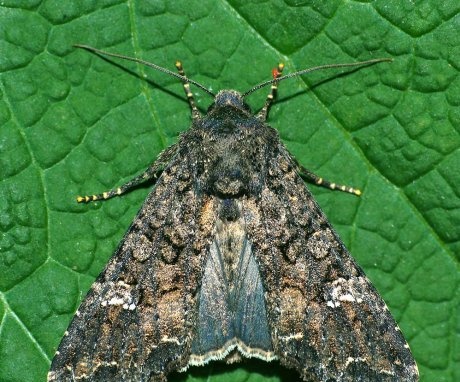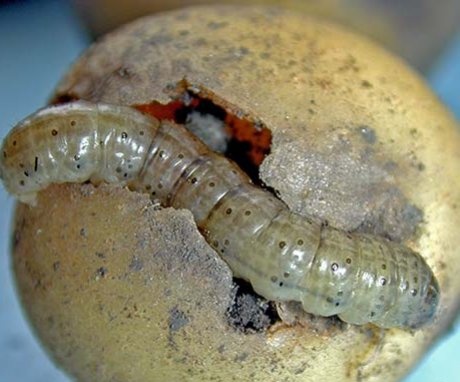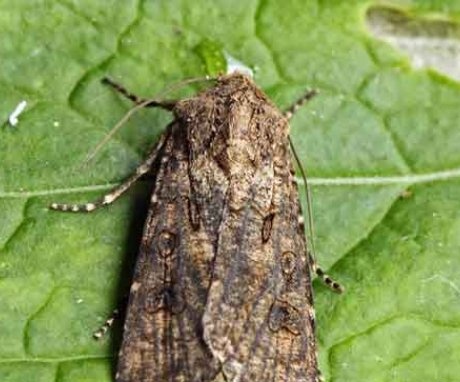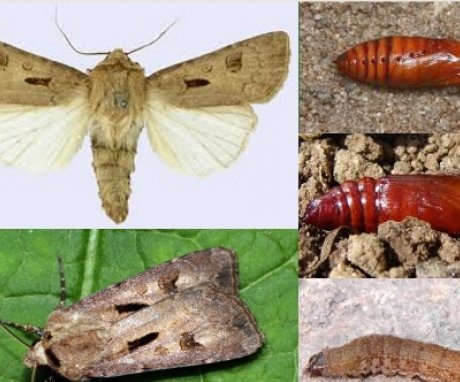Fighting the scoop: chemicals and folk methods
Among Lepidoptera, the scoop family is the most numerous and has more than 100 species. The most common types are considered: garden scoop, cabbage, potato, exclamation and ordinary pith. Butterflies differ in size and color, are considered harmless to the plants themselves, since they feed only on nectar. Therefore, you need to deal with the caterpillars of the scoop, which eat up various parts of the plants.
Content:
- Cabbage scoop control
- Preparations and alternative methods against the potato scoop
- Garden scoop - methods of struggle
- Piggy bank of folk wisdom: recipes for decoctions and infusions
Fighting the cabbage scoop
Cabbage scoop - polyphagous pest, but from vegetable crops prefers cabbage, peas, salad, beets and onion... The brown front wings of the butterfly are decorated with a lighter spot, and on the gray hind wings, darkening along the edges is clearly visible. Young caterpillars are light green in color, then turn brown-brown, oblique dark lines appear on the back.
The active lifestyle of caterpillars occurs at the end of July and August. Pests eat the leaves cabbage, making oblong passages in them, they climb inside the heads of cabbage, gnaw on the leaves and spoil the presentation of vegetables.
How to deal with a cabbage scoop:
- Sowing vegetables early in the garden is recommended.
- Mechanical way of fighting: collecting caterpillars and eggs by hand.
- Application of chemical drugs.
- The use of infusions and decoctions to combat caterpillars.
Of the chemical insecticides for controlling the scoop, KinMiks, Decis, IntaVir, Zeta, Fas can be advised. All drugs are diluted with water in accordance with the instructions. In addition, it is recommended to carry out foliar top dressing using superphosphate and potassium chloride.
Biological preparations such as Fitoverm, Bitoxybacillin, Lepidocide are recommended for multiple spraying. At least 1 week must elapse between the last treatment and harvest.
In addition to chemicals, it is effective to process vegetable crops with an infusion of bitter wormwood, hot pepper, burdock, tomato and potato tops.
It is recommended to make a bait for wasps on the site. They are a salvation for the harvest, since the insects themselves love to feast on caterpillars, rapidly destroying their numbers.
Preparations and alternative methods against the potato scoop
The potato scoop, or rather its caterpillar, brings great harm to the plant. During the growing season of plants, caterpillars make moves in the potato tops, after which it quickly withers and falls. Damaging the potato tuber, the caterpillars make a small hole, feed on the juice and pulp of the tuber, and then, crawl out, making an even greater stroke and leaving behind waste products. Caterpillar excrement causes tubers to rot.
The potato scoop is more harmful to plants and tubers if potatoes planted in low-lying areas where the soil is always moist. Wet years, when there are prolonged rains, bring great damage to the crop.
It is quite difficult to fight the potato scoop, as the butterfly is nocturnal. Spraying plants for the prevention of chemical preparations is not entirely justified, because all the work will have to be done late in the evening, waiting for the butterflies to fly out of their hiding places. It turns out that you cannot get rid of pests either, and a large dose of the introduced chemicals will be absorbed into the potato tubers and cause harm to health. We need to fight the caterpillars.
To reduce the number of pests, you should:
- Apply for planting potatoes mineral fertilizers.
- Destroy caterpillars by frequent loosening of the soil in the aisle.
- Carry out timely weeding, destroy weeds, wheatgrass, cereals, timothy.
- Plant potato at an earlier date.
In addition, when planting potato tubers, Bazudin in granules should be added to the aisle. A plot of 1 hectare will require 15 kg of bazudin. It is recommended to apply the drug in wet weather, so you can achieve a greater effect.
There are also safe methods of dealing with the scoop: attracting butterflies to the fermenting molasses.
Pests like such a treat and numerous individuals flock to its smell. To do this, you need to dilute molasses with water in a ratio of 1: 3, add yeast and pour the prepared drug into bottles, jars or other containers, which should be placed near the plantings. From time to time, add water and yeast.
During fermentation, a specific smell is released, which scoops flock to and drown in this liquid. You can replace molasses with fermented jam, beer wort, or beer. When using sugar syrup to catch scoops, the efficiency of the process will be noticeably reduced. Those scoops that have tasted fermenting molasses become sterile.
Garden scoop - methods of struggle
The most dangerous insect, harmful to many plants, but gives more preference tomatoes, radish, rutabaga and cabbage... The butterfly's bicolor wings are decorated with gray and yellow specks. Caterpillars are brown or green.
Why is a garden scoop dangerous? The fact is that the female lays eggs on almost all crops. She crawls under the leaf and lays eggs on the inside of the leaf plate. The caterpillars that appear feed on young foliage and fruits.
Methods of dealing with a garden scoop:
- Pest collection by hand.
- Installation of baits along the perimeter of the site.
- Exemption of the site from weeds: quinoa, nettle.
- The use of chemicals and folk methods to combat the scoop.
In spring, insecticides are used to process plantings: Decis, Proteus, Karate, Fury. In the summer, it is required to carry out treatment with preparations containing phosphorus, zolone, fufanol. During the dilution of chemicals, one should start from the form of the preparations: they are produced in powder form, in the form of granules, there are concentrated emulsions. Do not exceed the dosage.
The preparations are absorbed into vegetables, so processing is carried out no later than a month before harvesting.
During the growing season, it is allowed to carry out double processing. Fitoverm, Aktofit and Agrovertin are biological harmless drugs that are also used to control the scoop.
Piggy bank of folk wisdom: recipes for decoctions and infusions
Many gardeners do not use chemicals to combat certain pests. There are a number of folk recipes for infusions and decoctions that help to fight scoops in a completely harmless way to humans.
- Wormwood decoction. Pour 3 liters of water into a container, add 1 kg of chopped wormwood and boil for 15 minutes. The broth must be given time to infuse, then strain and process vegetables 2 times a week. 1 week should elapse between the first and subsequent spraying.
- Onion peel infusion. Scoop butterflies do not tolerate smell Luke, therefore, to scare them away, you can prepare an infusion of onion peels.To put the method into practice, you need to take a liter jar filled to the brim with onion husks, pour 2 liters of boiled water over it and let it brew for 2 days. Strain the resulting infusion, pour into a container and add water until 4 liters of the product are obtained. For better adhesion of the infusion to cabbage leaves, during cooking, you should add laundry soap, at the rate of 25 g per 4 liters of water.
- Burdock infusion. Grind the leaves of the plant, fill a 10-liter bucket with them to half, add water to the top and leave for 3 days. Strain the infusion before spraying. To ensure long-term protection of plants and for better "adhesion" of the infusion to the foliage, it is recommended to add laundry soap to the product, at the rate of 40 g per 10 liters of water. In a similar way, you can prepare effective infusions from potato tops, tomato leaves, yarrow, pharmacy chamomile, dope, aconite, milkweed.
In the daytime, it is almost impossible to fight the scoop. Due to the fact that she leads an active image at night, during the day she quietly and peacefully sleeps in the trees or in the grass, merging with the vegetation with the color of her body. The gardener has no choice but to fight against caterpillars and larvae. Timely processing of vegetable crops from vegetable, cabbage, potato scoops will help preserve the harvest.
More information can be found in the video.




